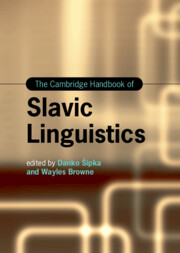Book contents
- The Cambridge Handbook of Slavic Linguistics
- Cambridge Handbooks in Language and Linguistics
- The Cambridge Handbook of Slavic Linguistics
- Copyright page
- Contents
- Figures
- Tables
- Contributors
- Introduction
- Part 1 Prosody and Phonology
- Part 2 Inflectional and Derivational Morphology
- Part 3 Syntax
- Part 4 Lexicon
- Part 5 Sociolinguistic and Geographical Approaches
- 26 Sociolinguistic Variation in Slavic Languages
- 27 False Cognates
- 28 Dialectal Fragmentation
- 29 Language Contacts
- 30 The Slavic Literary Micro-Languages
- 31 Heritage Language Forms
- 32 Scripts
- 33 Orthographies
- Part 6 Experimental and Quantitative Approaches
- Name Index
- Subject Index
- References
32 - Scripts
from Part 5 - Sociolinguistic and Geographical Approaches
Published online by Cambridge University Press: 16 May 2024
- The Cambridge Handbook of Slavic Linguistics
- Cambridge Handbooks in Language and Linguistics
- The Cambridge Handbook of Slavic Linguistics
- Copyright page
- Contents
- Figures
- Tables
- Contributors
- Introduction
- Part 1 Prosody and Phonology
- Part 2 Inflectional and Derivational Morphology
- Part 3 Syntax
- Part 4 Lexicon
- Part 5 Sociolinguistic and Geographical Approaches
- 26 Sociolinguistic Variation in Slavic Languages
- 27 False Cognates
- 28 Dialectal Fragmentation
- 29 Language Contacts
- 30 The Slavic Literary Micro-Languages
- 31 Heritage Language Forms
- 32 Scripts
- 33 Orthographies
- Part 6 Experimental and Quantitative Approaches
- Name Index
- Subject Index
- References
Summary
This chapter shows that the Slavic scripts roughly align with the cultural division between Slavia Orthodoxa and Slavia Latina. Although the Cyrillo-Methodian tradition of the Glagolitic script connected to the Old Church Slavonic language was originally not confined to either of the two areas and the Glagolitic script was used longest in Catholic Croatia, it is nowadays continued in the form of the Cyrillic script, whereas the Latin alphabet in Slavia Latina is based on a completely different, ‘Western’ tradition. However, mutual influences abound and can be seen in script changes and various instances of biscriptality as well as in the introduction of roman type in the West in the sixteenth century, the adoption of its design principles in the ‘civil type’ in the East in the eighteenth century, and the gradual replacement of both blackletter and Old Cyrillic, which was (almost) completed only in the twentieth century.
- Type
- Chapter
- Information
- The Cambridge Handbook of Slavic Linguistics , pp. 675 - 696Publisher: Cambridge University PressPrint publication year: 2024

